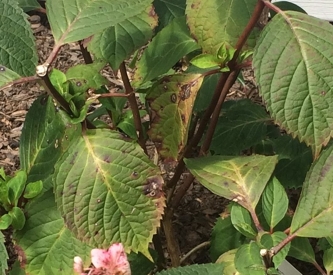The Of Hydrangea Leaves Turning Yellow
The Of Hydrangea Leaves Turning Yellow
Blog Article
All About Hydrangea Leaves Turning Yellow
Table of ContentsThe Facts About Hydrangea Leaves Turning Yellow RevealedRumored Buzz on Hydrangea Leaves Turning YellowNot known Incorrect Statements About Hydrangea Leaves Turning Yellow Unknown Facts About Hydrangea Leaves Turning YellowThe 6-Second Trick For Hydrangea Leaves Turning YellowHow Hydrangea Leaves Turning Yellow can Save You Time, Stress, and Money.
One opportunity is that the plant is not obtaining adequate sunshine. During the winter season months, the days are shorter, and the sun is not as intense, so ensure to place your Hydrangea in an area where it will get at the very least 6 hours of sunshine each day. An additional reason for Hydrangea yellow fallen leaves in winter can be way too much water.Lastly, the leaves could be turning yellow due to temperature stress. Hydrangeas like cooler temperature levels, so if the plant remains in a spot that gets also warm or too cool, the fallen leaves will certainly transform yellow. If you believe temperature stress may be the problem, attempt relocating your Hydrangea to a various area or shielding it from the components with a cloth wrap.
New development will be observed in very early springtime, when you'll discover green foliage sprouting from stems that could have appeared dead. If your fallen leaves are transforming brown in springtime or summer, there are most likely various other elements at play (Hydrangea Leaves Turning Yellow). The precise reasons depend on the range and their expanding conditions, however generally, brownish hydrangea leaves are a sign of dehydration and wilting in the warm
An Unbiased View of Hydrangea Leaves Turning Yellow
Wilting is created by lack of dampness, implying there are a couple of excellent tricks to use to avoid this from occurring. Offer your hydrangeas a healthy glug of water every few days when the temperature levels are climbing high, and treat the dirt to far better retain dampness. After sprinkling, a dab of mulch around the base of each plant ought to assist with this by maintaining moisture in the soil.
This interrupts fungis spores from settling. "The Botrytis fungus flourishes in great and wet problems, so avoid showering the entire plant when sprinkling and simply water at the roots," shares Roy Nicol, a Master Gardener. If you've missed the possibility for prevention and are handling an infection you must remove all dead or significantly contaminated fallen leaves from the plant and ruin them to avoid further spread.
The Ultimate Guide To Hydrangea Leaves Turning Yellow
As a basic guideline, we advise getting rid of fallen leaves when they are 50% brown or higher. While browning triggered by any reason can not be turned around, taking the restorative activity defined above will encourage the plant to expand brand-new leaves so the harmed fallen leaves either diminish normally or can be removed by the gardener.
Hydrangeas ought to be sprinkled just when the leading few inches of soil are completely dry, and need to be given a comprehensive soaking each time. Underwatered hydrangeas are likely to have yellow, wilting, and sagging fallen leaves. Raise the frequency and amount of watering for your hedge to Continue assist solve this concern. Hydrangeas favor rather damp (however not soaked) soil, so provide the roots a good soaking and allow water to be soaked up right into the soil before applying a lot more.
The means you repair hydrangea see post leaves transforming yellow depends upon the vital issue triggering the yellow fallen leaves. This can be difficult to establish, once you do you will certainly be able to adjust your plant care accordingly to take treatment of the problem. As stated before, an usual issue with hydrangeas is nutrient deficiencies.
Our Hydrangea Leaves Turning Yellow Ideas
During the top growing season, you should sprinkle at a price of regarding 1 inch each week. If you are stressed over not properly sprinkling your hydrangeas, there are a pair of points you can do. Including mulch to the base of the plants read over the root zone help to regulate the temperature around the shrub and keep water in the soil.
Alternatively, you can purchase and set up straightforward watering worlds. Watering globes hold water in them and gradually release this water into the dirt as the ground ends up being completely dry. Just fill up the globe with water, stick the spout right into the soil within the root area near the base of the plant, and leave it in area up until all the water is gone.
If it is also extreme, some plants will certainly never recuperate from transplant shock and will certainly remain to decline up until they die. Reduce transplant shock by including as lots of origins as feasible when digging up your plant to relocate. Be certain to offer more water than usual in the weeks following growing to aid your plant recuperate and grow brand-new roots.
How Hydrangea Leaves Turning Yellow can Save You Time, Stress, and Money.
To prevent spreading out fungal conditions, make certain to thouroughly clean and disinfect any trimming tools prior to and after usage. Finally, you can try to purge the roots with water to get rid of excess fertlizer.
Your hydrangea plant likes well-drained, moist dirt. If the pot has poor drain, or your soil is swamped, the leaves will certainly start to transform yellow. Overwatering makes the dirt soaked (Hydrangea Leaves Turning Yellow). Flooded and soaked soil can cause stunted growth, leaf staining, and, worst of all, rot fungal illness. Despite the fact that over-watering can be hazardous, under-watering is not an alternative either.
If you do not water your hydrangea plant for more than a week, the leaves will begin turning yellow. Fungal diseases that assault the plants have a tendency to show signs on the roots and the leaves of the plant.
Not known Facts About Hydrangea Leaves Turning Yellow

Report this page